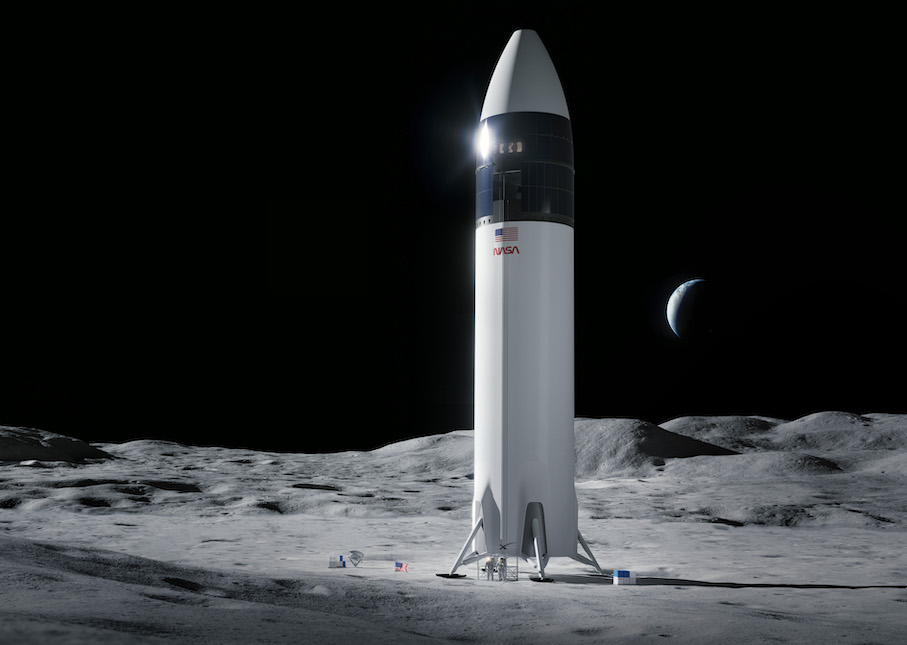WASHINGTON — As NASA pushes ahead with a crewed lunar landing on the Artemis 3 mission in September 2026, the agency’s own analysis estimates a nearly one-in-three chance the lander will be at least a year and a half late.
That assessment came from a confirmation review for the Human Landing System (HLS) Initial Capability project, which is supporting the development of SpaceX’s Starship lunar lander that will be used on Artemis 3. The confirmation review, known in agency parlance as Key Decision Point (KDP) C, sets cost and schedule commitments for NASA projects.
The confirmation review, which took place in December 2023, set a schedule baseline of February 2028 for that project at a 70% joint confidence level. That means there is a 70% chance that Starship will be ready for a lunar landing — a milestone formally known as lunar orbit checkout review — by February 2028.
“The joint cost and schedule confidence level is an integrated analysis of a project’s cost, schedule, risk, and uncertainty, which indicates a project’s likelihood of meeting a given set of cost and schedule targets,” stated the Government Accountability Office in a June 20 report assessing major NASA programs.
That date is nearly a year and a half after NASA’s current schedule of September 2026 for Artemis 3. The 70% joint confidence level also means that the agency believes there is a 30% chance that the Starship lander will not be ready until after February 2028.
The confirmation review, not widely publicized by NASA when it was completed, was mentioned the GAO report. It noted that schedule assessment is independent of the readiness of other aspects of the mission, such as the Space Launch System, Orion spacecraft and new lunar spacesuits.
In a statement to SpaceNews, NASA confirmed the dates mentioned in the GAO report, while reiterating that Artemis 3 remains on schedule for September 2026. “The GAO report’s cost and schedule baseline figures are accurate, risk-informed estimates at the 70% joint confidence level (JCL). The agency use of a 70% JCL to inform baseline estimates is a conservative approach that assumes broad risk realization,” it stated.
“NASA continues to have confidence in SpaceX as a provider to help achieve the Artemis III mission,” the statement added.
The KDP-C also set a cost of $4.9 billion for HLS Initial Capability at the same 70% joint confidence level. That includes the $2.9 billion fixed-price contract to SpaceX, awards to SpaceX, Blue Origin and Dynetics in the earlier phase of the project and NASA project office costs.
Cathy Koerner, NASA associate administrator for exploration systems development, reiterated the 2026 date for Artemis 3 at a June 7 meeting of the National Academies’ Space Studies Board. That meeting took place a day after the fourth integrated test flight of Starship and its Super Heavy booster.
“From a Human Landing System project status, SpaceX continues to make great progress,” she said citing the latest flight and other work, such as an integrated test of the elevator that astronauts will use to descend to the surface from the Starship cabin.
She noted, though, that the HLS effort faces “a lot of technical challenges.” The next major milestone, she said, was an in-space cryogenic propellant transfer test, which she said was planned for early 2025.
The GAO report also emphasized the importance of that test. During the confirmation review, a standing review board “recommended that SpaceX’s in-space propellant transfer tests inform the program’s critical design review, currently planned for 2025.”
At the Space Studies Board meeting, Koerner played down reports that NASA was considering an alternative plan that would test Starship and Orion in low Earth orbit, analogous to the Apollo 9 mission, but acknowledged that that the agency was planning for contingencies.
She said NASA did a lot of “next-worse failure” assessments, looking at what happens if one element of the mission was not available. “We’re always doing those kinds of backup plans,” she said. “We have not made any changes to the current plan as I outlined it here today, but we have lots of people looking at lots of backup plans so that we are doing due diligence.”
Related

Dr. Thomas Hughes is a UK-based scientist and science communicator who makes complex topics accessible to readers. His articles explore breakthroughs in various scientific disciplines, from space exploration to cutting-edge research.








